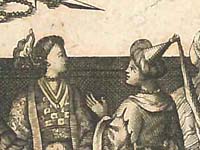Theatrum heroinarum
|
Theatrum Annuum Historico-Morale Heroinarum. Oder: Jährliche sittliche Geschichts Schau-Bühne der Heldinen. [...] Eröffnet Von P. Fr. Ivone Hueber. - Augspurg und Grätz : In Verlag Philipp, Johann, und Martin Veith. [First Part] 1717. Austrian National Library, shelfmark: 310.279-B.Alt-Mag.1 To put on stage the knowledge of the time, to bring it to life in front of an eager audience in a sequel of scenes – in addressing its readers, the Theatrum Literature of early modern times employed the terms and techniques of the theatre. The frontispice of the Theatrum annuum historico-morale heroinarum (left) visualizes this idea by showing the heroines of the narrative against a typically baroque backdrop.
For his large-scale book project, the Franciscan monk Ivo Hueber intended to write a „performance“ each for every day of the year. Thus the first volume (the only one actually printed) comprises ninety chapters for the months January to March. Each performance is dedicated to a specific topic, many of them featuring – not surprisingly – traditional female virtues and heroines patiently suffering under, but also bravely holding out against oppression.
But Hueber also introduces „splendid and world-famous regents“, „fearless martial and warlike women“ and „highly skilled“ as well as „sapient and erudite“ women, among them the famously learned Anna Maria Schurmann (1607-1678), Elisabeth of the Palatinate (1618–1680), abbess of Herford, and Helena Sybilla Moller, daughter of the eminent linguist J. Chr. Wagenseil and linguistically gifted herself. He doesn’t withhold his praise even for the „heretic queen of England” Elizabeth I., a highly accomplished speaker and fluent in Latin. Hueber trusts that women are „capable of [mastering] all languages, arts and sciences”, but suspects that „men won’t allow it, out of fear of being outdone by them”. A structured table of contents allows the reader to search the book for names of authors’ and personal names, subjects, illustrative examples and even scripture references, as many of the stories about virtuous women are taken from the bible. |


